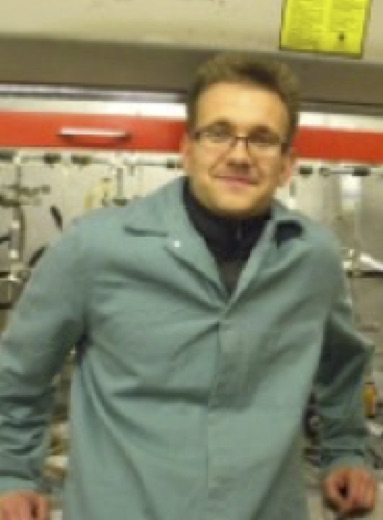Org. Synth. 2017, 94, 388-398
DOI: 10.15227/orgsyn.094.0388
Preparation of Benzyl((R)-2-(4-(benzyloxy)phenyl)-2-((tert-butoxycarbonyl)amino)acetyl)-D-phenylalaninate using Umpolung Amide Synthesis
Submitted by Matthew T. Knowe, Sergey V. Tsukanov, and Jeffrey N. Johnston*
1
Checked by Manuela Brütsch, Estíbaliz Merino, and Cristina Nevado
1. Procedure (Note 1)
Benzyl ((R)-2-(4-(benzyloxy)phenyl)-2-((tert-butoxycarbonyl)amino)acetyl)-D-phenylalaninate (2). A three-necked, 1-L round-bottomed flask is equipped with an overhead mechanical stirrer in the central neck (
Note 2). A septum and a glass stopper are placed in the other two necks. The (
R)-bromonitroalkane
2 (
1) (8.90 g, 19.7 mmol, 1.0 equiv, 1:1 dr, 99/99% ee),
D-phenylalanine benzyl ester hydrochloride (7.10 g, 23.7 mmol, 1.2 equiv), and
cesium carbonate (20.64 g, 63.1 mmol, 3.2 equiv) (
Note 3) are loaded into the flask. Deionized
water (35 mL) and
2-Me-THF (200 mL) (
Note 4) are poured into the vessel through the neck bearing the glass stopper. An oxygen balloon is then placed into the septum, and the bright yellow mixture is stirred at maximum speed at room temperature for 7 min (Figure 1a).
N-Iodosuccinimide (4.47 g, 19.7 mmol, 1.0 equiv) (
Note 5) is then added in one portion through the neck bearing the glass stopper (dark yellow mixture to brown mixture, Figures 1b-d). The reaction mixture is stirred for 24 h (
Note 6).
Figure 1. Reaction set up. A) reaction mixture before the addition of N-iodosuccinimide; b) reaction mixture after addition of N-iodosuccinimide; c) reaction mixture after 26 h stirring at room temperature; d) reaction mixture after quenching with sat. aq. Na2S2O3.
To quench the reaction, sat. aq.
Na2S2O3 (50 mL) (
Note 7) is poured into the stirring reaction and allowed to stir for 1 h. The mixture is then poured into a 1-L separatory funnel, using
EtOAc (50 mL) to rinse the remaining mixture into the funnel. The organic and aqueous layers are separated, and the latter is extracted with
EtOAc (2 x 50 mL). The combined organic layers are dried over
MgSO4 (25 g) (
Note 8), filtered, and concentrated to a red oil in a 1-L round-bottomed flask by rotary evaporation (40 °C, 110-80 mmHg) (Figure 2a). The oil is transferred onto a pad of silica (8 cm tall by 7 cm wide), using
dichloromethane (10 mL) to retrieve the residual oil and
EtOAc:hexanes (1:1) (30 mL) to rinse the flask. The silica is then flushed with
EtOAc:hexanes (1:1) (600 mL) into a 1-L round-bottomed flask and is concentrated to a red solid by rotary evaporation (40 °C, 110-80 mmHg). The material is subjected to high vacuum (0.25 mmHg) for 1 h. To the crude solid is added
toluene/
cyclohexane (3:2) (50 mL) and heated in a warm water bath (70 °C) until all solids are dissolved (
Note 9). The flask is then removed from the water bath, capped with a plastic stopper, and allowed to cool to room temperature (25 °C) for 2 h. The flask is cooled to 0 ºC in a freezer for 19 h. The suspension is vacuum filtered through a Büchner funnel (7 cm diameter), fitted with filter paper. Cold
cyclohexane (3 x 25 mL) is used to rinse the remaining powder from the round-bottomed flask onto the filter cake (Figure 2b). The solid is transferred into a tared 100 mL round-bottomed flask and dried by high vacuum (0.25 mmHg) for 12 h to give a beige solid (Figure 2c) (6.59 g, 56% yield) (Notes
10 and
11).
Figure 2. a) Brown oil before filtration through silica; b) Product after filtration through silica; c) Product after crystallization.
2. Notes
1. Prior to performing each reaction, a thorough hazard analysis and risk assessment should be carried out with regard to each chemical substance and experimental operation on the scale planned and in the context of the laboratory where the procedures will be carried out. Guidelines for carrying out risk assessments and for analyzing the hazards associated with chemicals can be found in references such as Chapter 4 of "Prudent Practices in the Laboratory" (The National Academies Press, Washington, D.C., 2011; the full text can be accessed free of charge at
https://www.nap.edu/catalog/12654/prudent-practices-in-the-laboratory-handling-and-management-of-chemical). See also "Identifying and Evaluating Hazards in Research Laboratories" (American Chemical Society, 2015) which is available via the associated website "Hazard Assessment in Research Laboratories" at
https://www.acs.org/content/acs/en/about/governance/committees/chemicalsafety/hazard-assessment.html. In the case of this procedure, the risk assessment should include (but not necessarily be limited to) an evaluation of the potential hazards associated with
tert-Butyl ((1R)-1-(4-(benzyloxy)phenyl)-2-bromo-2-nitroethyl)carbamate,
D-phenylalanine benzyl ester hydrochloride,
cesium carbonate,
2-methyltetrahydrofuran,
N-iodosuccinimide,
sodium thiosulfate,
ethyl acetate,
magnesium sulfate, hexanes,
dichloromethane, silica gel,
toluene, and
cyclohexane, as well as the proper procedures and precautions for the use of an oxygen balloon
.2. A T Line Laboratory Stirrer model from Heidolph was used at maximum speed with a 7 cm x 1 cm paddle.
3. (
R)-Bromonitroalkane
1 was prepared according to a previously published procedure,
2 and the enantiomeric excess was determined to be 99/99% by Chiral HPLC analysis (Chiralcel AD-H, 20%
iPrOH/hexanes, 1 mL/min,
tr(d
1e
1, major) = 15.6 min,
tr(d
1e
2, minor) = 19.3 min,
tr(d
2e
2, minor) = 20.4 min,
tr(d
2e
1, major) = 26.1 min).
D-Phenyl alanine benzyl ester hydrochloride (97%) was purchased from Ark Pharm and used as supplied.
Cesium carbonate was purchased from Fluorochem (99%) and used as supplied.
4.
2-Me-THF (>99.0%, containing 250 ppm BHT) was purchased from Sigma-Aldrich and was distilled prior to use.
5.
N-Iodosuccinimide (98%) was purchased from Fluorochem and used as received.
6. Reaction progress was monitored by aliquot removal and NMR analysis. The NMR aliquots were prepared according to the following quench procedure: 100 μL of the reaction mixture was loaded onto a 15%
Na2S2O3/silica plug in a pipette. The plug was flushed with 5 mL of
EtOAc into a round-bottomed flask, and the solution was concentrated in a rotavap and dried for 5 min at high vacuum (0.1 mmHg). The residue was dissolved in CDCl
3 and analyzed by
1H NMR.
7.
Sodium thiosulfate pentahydrate (>99.5%) was purchased from Sigma-Aldrich and used as received.
8.
Magnesium sulfate was purchased from Merck and used as received.
9.
Toluene (>99.9%) and
cyclohexane (99+%) were purchased from Sigma Aldrich and Alfa Aesar, respectively.
Toluene was collected from a dry solvent system (Innovative Technology).
10. Dipeptide
2: R
f = 0.31 (25%
EtOAc/hexanes; >99% purity (Q NMR, DMF internal standard); mp = 121-123 °C;
1H NMR
pdf(400 MHz, CDCl
3) δ: 1.41 (s, 9H), 3.07 (dd,
J = 14.0, 5.7 Hz, 1H), 3.15 (dd,
J = 13.9, 6.0 Hz, 1H), 4.85 (dd,
J = 13.0, 6.2 Hz, 1H), 5.03 (s, 3H), 5.05 (d,
J = 12.7 Hz, 1H), 5.11 (d,
J = 12.2 Hz, 1H), 5.60 (br s, 1H), 6.19 (br d,
J = 7.2 Hz, 1H), 6.89 (d,
J = 8.4 Hz, 2H), 6.95-6.97 (m, 2H), 7.17-7.24 (m, 7H), 7.33-7.43 (m, 8H) ppm;
13C NMR
pdf(126 MHz, DMSO-
d6) δ: 28.1, 36.5, 53.7, 56.8, 66.0, 69.1, 78.3, 114.4, 126.5, 127.6, 127.8 (2C), 127.9, 128.2, 128.3, 128.4 (2C), 129.1, 130.8, 135.6, 136.9, 137.1, 154.7, 157.7, 170.2, 170.9 ppm; IR (film) 3318, 2974, 1739, 1713, 1661, 1508, 1455, 1369, 1239, 1164, 1024, 735, 696 cm
-1; HRMS (EI): Exact mass calcd for C
36H
39N
2O
6 [M + H]
+ 595.28026, found 595.27984. Note: CDCl
3 was used for
1H NMR characterization instead of DMSO-
d6 because of the sharpness of the spectrum and the minimal peak overlap with DMF for QNMR
pdf.
11. When the procedure was carried out in a half scale reaction with
(S)-bromonitroalkane (
1) and
L-phenylalanine benzyl ester hydrochloride, 3.22 g (55% yield) of the enantiomer of product
2 (
benzyl((S)-2-(4-(benzyloxy)phenyl)-2-((tert-butoxycarbonyl)amino)acetyl)-L-phenylalaninate) was obtained.
Working with Hazardous Chemicals
The procedures in
Organic Syntheses are intended for use only by persons with proper training in experimental organic chemistry. All hazardous materials should be handled using the standard procedures for work with chemicals described in references such as "Prudent Practices in the Laboratory" (The National Academies Press, Washington, D.C., 2011; the full text can be accessed free of charge at
http://www.nap.edu/catalog.php?record_id=12654). All chemical waste should be disposed of in accordance with local regulations. For general guidelines for the management of chemical waste, see Chapter 8 of Prudent Practices.
In some articles in Organic Syntheses, chemical-specific hazards are highlighted in red "Caution Notes" within a procedure. It is important to recognize that the absence of a caution note does not imply that no significant hazards are associated with the chemicals involved in that procedure. Prior to performing a reaction, a thorough risk assessment should be carried out that includes a review of the potential hazards associated with each chemical and experimental operation on the scale that is planned for the procedure. Guidelines for carrying out a risk assessment and for analyzing the hazards associated with chemicals can be found in Chapter 4 of Prudent Practices.
The procedures described in Organic Syntheses are provided as published and are conducted at one's own risk. Organic Syntheses, Inc., its Editors, and its Board of Directors do not warrant or guarantee the safety of individuals using these procedures and hereby disclaim any liability for any injuries or damages claimed to have resulted from or related in any way to the procedures herein.
3. Discussion
Arylglycine α-amino amides are constituent residues within numerous biologically important molecules, including glycopeptide antibiotics (vancomycin, teicoplanin, ristomycin) and α-lactam antibiotics (nocardicins A-G, amoxicillin).
3 Arylglycine amino acids can be accessed enantioselectively using chiral auxiliary directed azidation,
4 Sharpless asymmetric dihydroxylation
5 and aminohydroxylation of styrenes,
6 hydrogenation of imino esters,
7 and copper catalyzed diazo insertion into N-H bonds.
8 However, this important motif can be difficult to incorporate in peptides by standard dehydrative amide coupling strategies, which typically involve formation of an active ester intermediate from the amino acid.
9 Upon ester activation, the α-proton is acidified, making epimerization more likely. In the case of active ester intermediates of aryl glycine amino acids, this risk of epimerization is exacerbated by the acidifying effect of the aryl ring.
We addressed this issue in a report using an organocatalyzed aza-Henry reaction
10 for the preparation of α -bromo nitroalkanes, and their use in Umpolung Amide Synthesis (UmAS) using an amine, inorganic base, and oxidant
11 (Scheme 1).
Scheme 1. Preparation of Arylglycine Containing Peptides by Enantioselective aza-Henry and Umpolung Amide Synthesis
We hypothesized that the amine and oxidant form an electrophilic species (e.g. an
N-halamine) with which the α-bromo nitronate can react. A mechanistic study revealed that the resulting tetrahedral intermediate can collapse in an aerobic or anaerobic fashion to furnish the amide product.
12 Overall, this would constitute a polarity reversal for reactants in the traditional amide bond forming paradigm - the nucleophilic nitronate carbon becomes the amide carbonyl carbon, and the iodamine nitrogen is electrophilic (Umpolung reactivity). This mechanism predicts that stereocenters adjacent to the carbonyl surrogate would not be acidic at any point leading to the amide. This aza-Henry/UmAS strategy has been successfully applied to the preparation of α-oxy amides,
13 aryl glycines,
14 and aliphatic
D and
L amino acids.
15 Catalytic methods have been developed for the use of substoichiometric
N-iodosuccinimide16 and the use of simple nitroalkanes in UmAS.
17 UmAS has been extended to heterocycle synthesis
18 as well as enlisted in the production of depsipeptide macrocycles.
19This method directly addresses the challenges of arylglycine synthesis by dehydrative methods, by leveraging the UmAS mechanism to skirt an active ester intermediate, delivering an epimerization-free synthesis of an arylglycine-containing peptide. Given the frequency with which para-hydroxy aryl glycine is displayed by natural products, its multigram preparation was targeted, and protection of the phenolic hydroxyl as a benzyl ether was deemed optimal.
Appendix
Chemical Abstracts Nomenclature (Registry Number)
L-Phenylalanine benzyl ester hydrochloride (2462-32-0)
Cesium carbonate (534-27-8)
2-Methyl THF (96-47-9)
N-Iodosuccinimide (516-12-1)
Sodium thiosulfate (7772-98-7)

|
Matthew T. Knowe completed his B.S. Biochemistry degree at College of Charleston in 2012 where he conducted undergraduate research in mechanistic enzymology with Dr. Marcello Forconi. In 2012 he began his Ph.D. studies at Vanderbilt University in the laboratory of Dr. Jeffrey N. Johnston where he has studied natural product total synthesis and organocatalysis. |

|
Sergey Tsukanov completed his Master's Degree from Moscow State Academy of Fine Chemical Technology in 2007. He received his Ph.D. in organic chemistry under the guidance of Prof. Daniel L. Comins at North Carolina State University where he studied the total synthesis of complex alkaloids. In 2012 he started his postdoctoral training at Vanderbilt University focusing on synthesis of the peptidic natural product feglymycin using Umpolung Amide Synthesis and enantioselective aza-Henry chemistry. He received a Lilly Innovation Fellowship Award in 2013 and led a collaborative project to develop a continuous flow paradigm appropriate for nitroalkane synthesis and enantioselective organocatalysis. He is currently a Research Scientist in Small Molecule Design and Development at Eli Lilly. |

|
Jeffrey N. Johnston completed his B.S. Chemistry degree at Xavier University in 1992, and a Ph.D. in organic chemistry at The Ohio State University in 1997 with Prof. Leo A. Paquette. He then worked as an NIH postdoctoral fellow with Prof. David A. Evans at Harvard University. He is currently a Stevenson Professor of Chemistry at Vanderbilt University, and a member of the Institute of Chemical Biology. His group has developed a range of new reactions and reagents that are used to streamline the chemical synthesis of complex small molecules. The integration of new enantioselective Brønsted acid-catalyzed reactions with target-oriented synthesis is an ongoing investigational theme. |

|
Manuela Brütsch completed her Masters Degree in Chemistry in 2014 at the University of Zurich with Prof. Cristina Nevado. She then joined Prof. Jay S. Siegel's group at the Tianjin University in China to work as Research Assistant, followed by an appointment at the Scripps Research Institute in La Jolla with Prof. Dale Boger. In October 2016 she returned to the University of Zurich where she is working in Prof. Cristina Nevado's group. |

|
Estíbaliz Merino obtained her Ph.D. degree from the Autónoma University (Madrid-Spain). After a postdoctoral stay with Prof. Magnus Rueping at Goethe University Frankfurt and RWTH-Aachen University in Germany, she worked with Prof. Avelino Corma in Instituto de Tecnología Química-CSIC (Valencia) and Prof. Félix Sánchez in Instituto de Química Orgánica General-CSIC (Madrid) in Spain. At present, she is a Research Associate in Prof. Cristina Nevado´s group in University of Zürich. She is interested in the synthesis of natural products using catalytic tools and in the development of new materials with application in heterogeneous catalysis. |
Copyright © 1921-, Organic Syntheses, Inc. All Rights Reserved